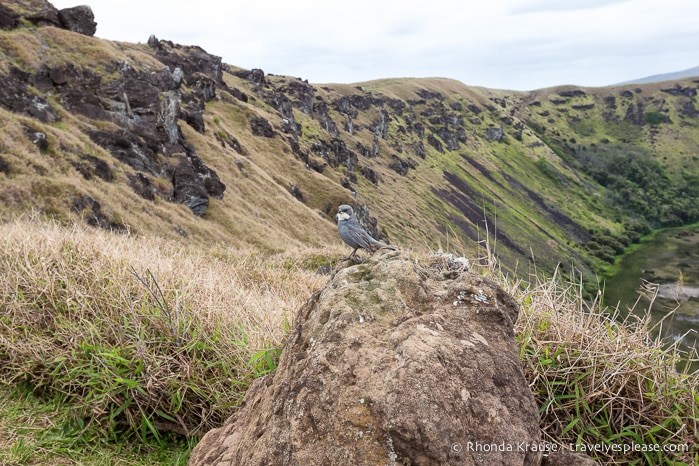Orongo- Ceremonial Village of the Birdman Cult
Purchases made through links earn us a small commission, at no extra cost to you.
Set between the sprawling crater of Rano Kau and the plunging cliffs of Easter Island’s southwest coast, is the small ceremonial village of Orongo.
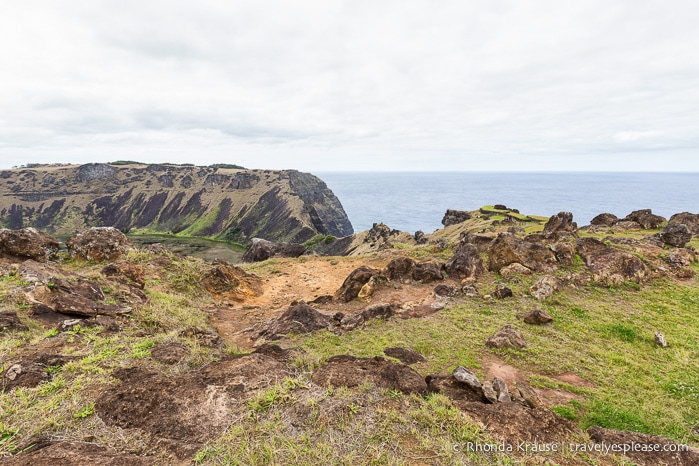
Orongo is a much different site than any other place on Easter Island. There are no famous moai statues and no huge ceremonial platforms. It’s the only place on the island you can see historic stone dwellings and delve deep into the fanciful tales of the Birdman competition.
Orongo may not be as widely known as Easter Island’s moai, but it still is an incredible site. What Orongo lacks in “fame” it makes up for with its breathtaking location, exceptional restorations and riveting stories.
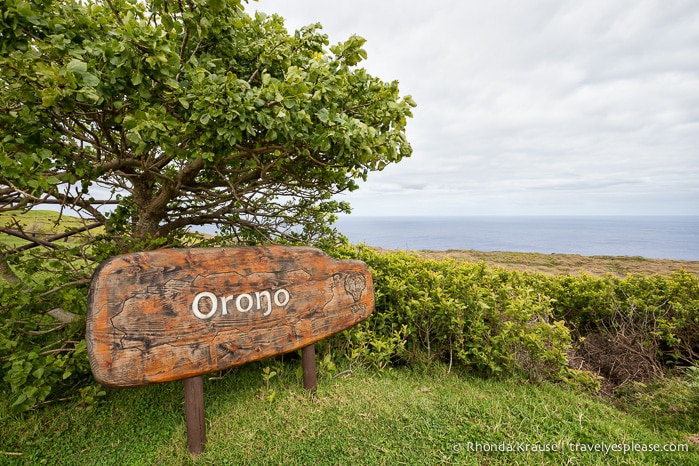
About Orongo
Throughout its history, Orongo has always been a seasonal village, used only a few weeks out of the year for special celebrations and ceremonies. The harsh coastal winds and the lack of access to the ocean made Orongo impractical for people to live year round.
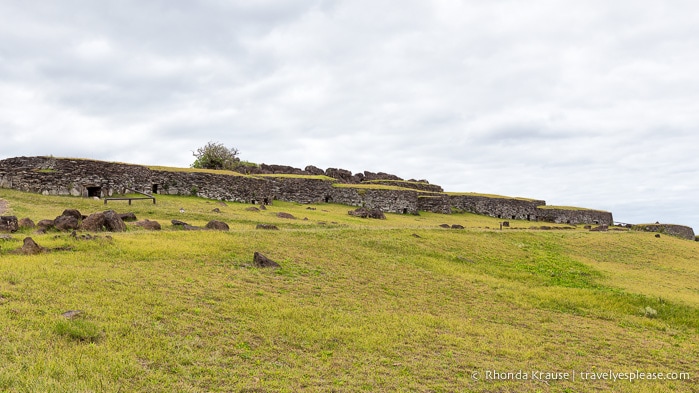
As resources on Easter Island dwindled, the moai-carving culture collapsed and tribal wars ensued. Tribal chiefs and priests lost their influence on society and the warrior class (matato’a) took charge, instilling new religious and social beliefs.
The change in power gave rise to the Birdman cult and their annual Birdman competition.
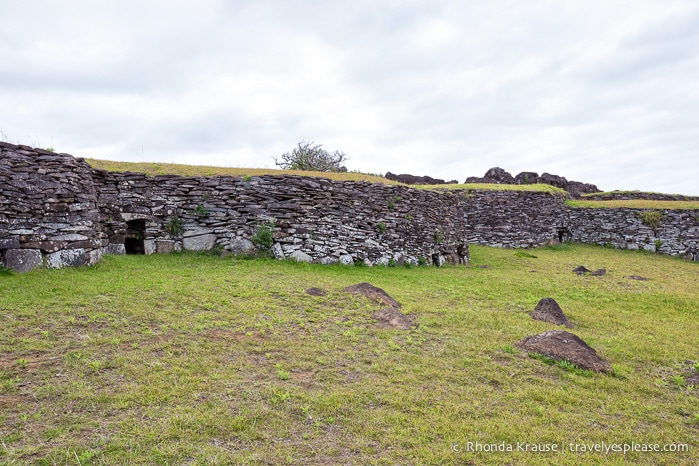
The Birdman Competition
The Birdman competition was an opportunity for the tribes on Easter Island to show their physical strength and compete for leadership of the island.
Every spring, each chief would select a competitor (hopu manu) to represent him in the Birdman competition at Orongo.
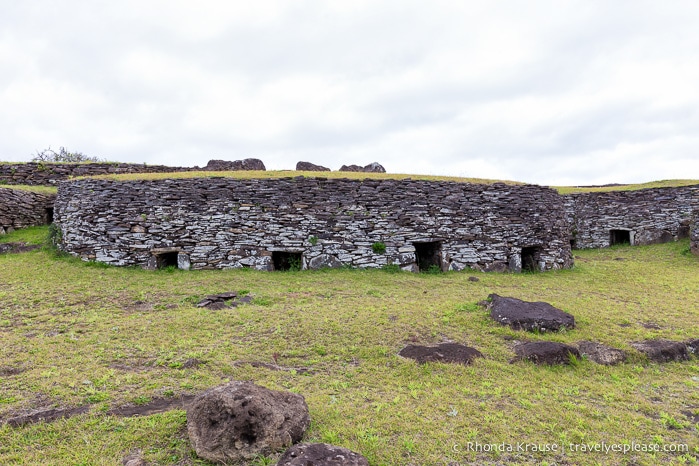
Once the event started, contestants would climb down the cliff, swim on a reed surfboard to the small island of Motu Nui (2 km away), and try to be the first to find a sooty tern (manutara) egg. Sometimes it took days, even weeks before the sooty terns arrived to lay their eggs. Once an egg was found, the lucky contestant had to swim back to Orongo, without breaking the egg, to win the competition.
The elder that the contestant represented was then crowned the Birdman (tangata-manu) and his clan was entitled to certain rights on the island for a year.
If that wasn’t strange enough, the Birdman would then go into seclusion for one year in a special ceremonial house. I’m not sure I would want that prize!
It’s believed that the Birdman competition took place for about a century and a half, the last race happening in 1867.
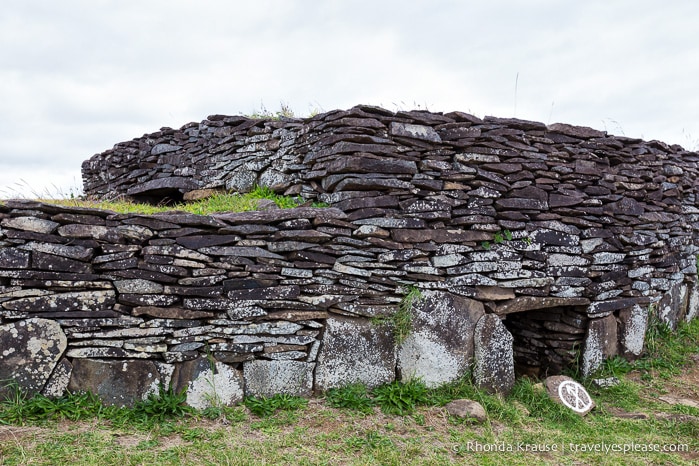
Our Visit to Orongo- Exploring Orongo Village
Orongo was an easy site to visit without a guide because at the entrance you are given a pamphlet/map of the village with areas of interest marked, numbered and explained. The path that loops around the site is numbered to correspond with the map, so you can easily read about what you are looking at.
The first place we encountered was a lookout point where you get a clear view of Motu Nui, the small island the Birdman competitors would swim to in search of the coveted sooty tern egg. You’d have to be very brave to attempt that swim!
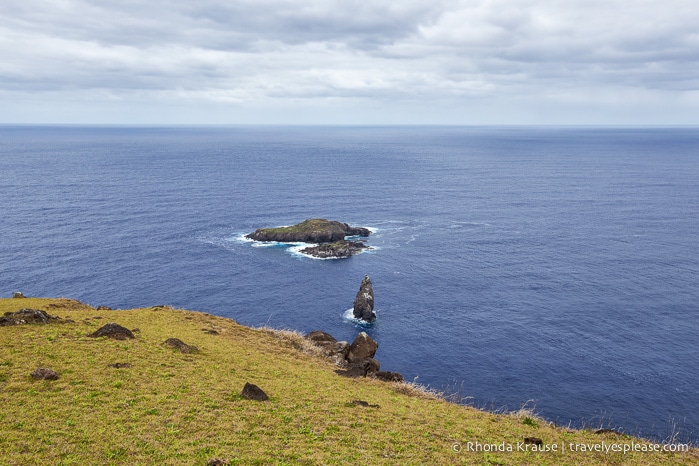
Close to the lookout we saw remains of two houses that were not rebuilt during the village’s reconstruction. It was interesting to see the contrast between how the area was found and what the buildings looked like during the time of the Birdman cult.
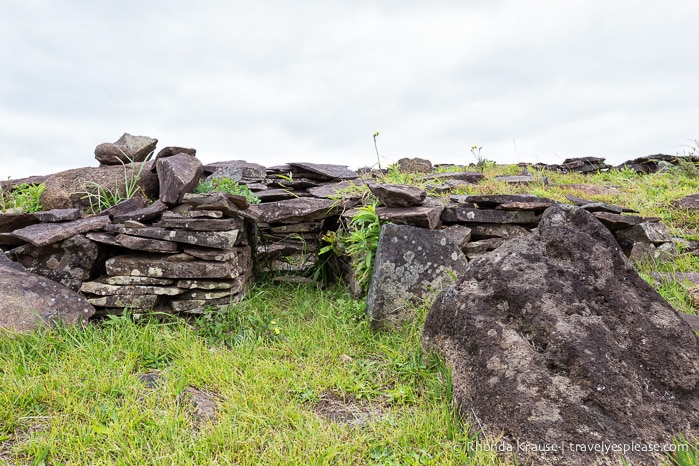
From here we moved on to a house that has been partially restored. You can see what it looked like inside because half of the roof has not been placed on top. It was a very small space, used only for sleeping.
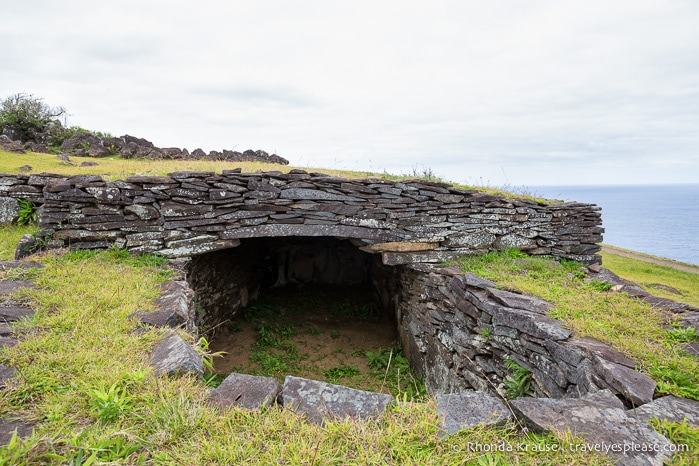
The path then led us past a row of stone-slab houses, their tiny doors facing the ocean and islands across from them. Each house had a front lawn where social activities would take place. I could imagine people gathering here, singing and dancing as they celebrated the start of the Birdman competition.
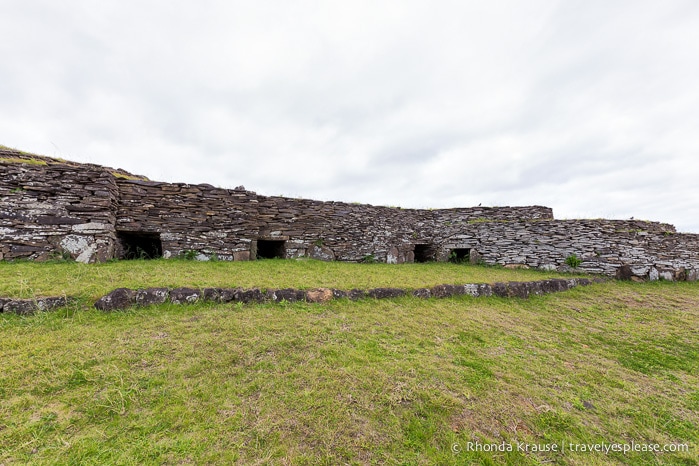
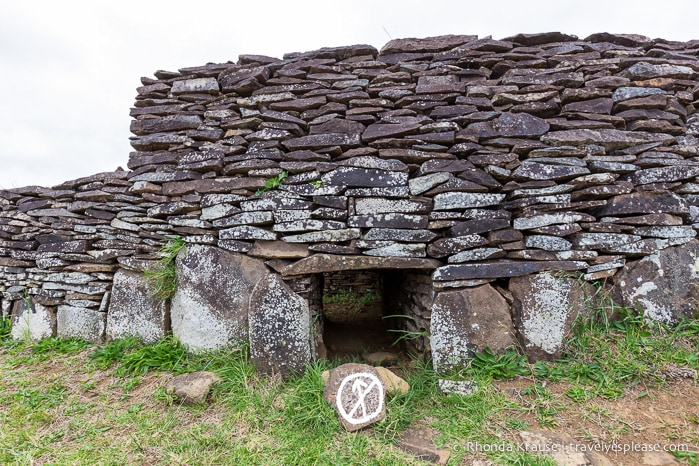
We also saw the spot where a basalt moai (Moai Hoa Haka Nana la) once stood. This particular moai is famous for the petroglyphs related to the Birdman competition carved on its back. I would have loved to see it, but it was taken from Orongo in 1868 and now is on display at the British Museum in London.
At the furthest point of Orongo there is an area with approximately 1700 petroglyphs carved into the rocks. Unfortunately, due to erosion increasing the instability of the ground, this site is no longer accessible to the public. It would have been very interesting to see the petroglyphs still standing in the main ceremonial area where the priests would wait for the winner to deliver the egg. I just hope that something can be done to protect the petroglyphs before they slip into the ocean!
Continuing along the path, we soon came to a lookout with a nice view of the volcano crater. Even though we had hiked along the edge of Rano Kau to get to Orongo, I was still blown away by the size of this crater.
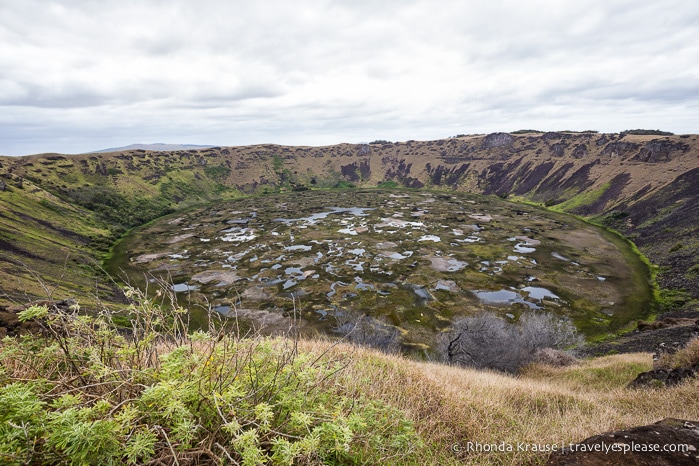
Moving along, we arrived at the quarry area where the stone used to make Orongo’s houses was taken from.
The last notable site is a place where a shrine once stood but now lies in ruins.
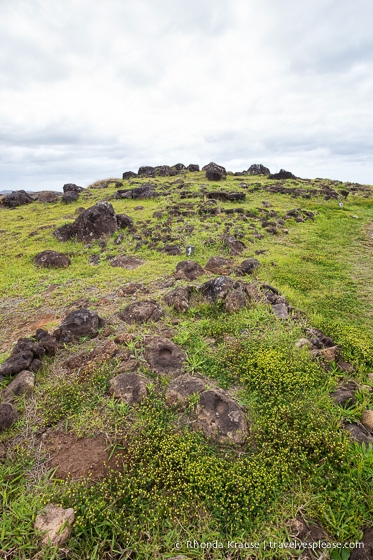
Before leaving Orongo, we spent some time at the visitor centre. The displays have a lot of great information about Orongo and its history, so it’s worth making a visit.
Final Thoughts About Orongo
We didn’t know anything about Orongo, had actually never even heard of it before arriving on Easter Island, so we were pleasantly surprised by what we saw.
The stone houses are beautifully restored and the views to both the ocean and crater are fabulous.
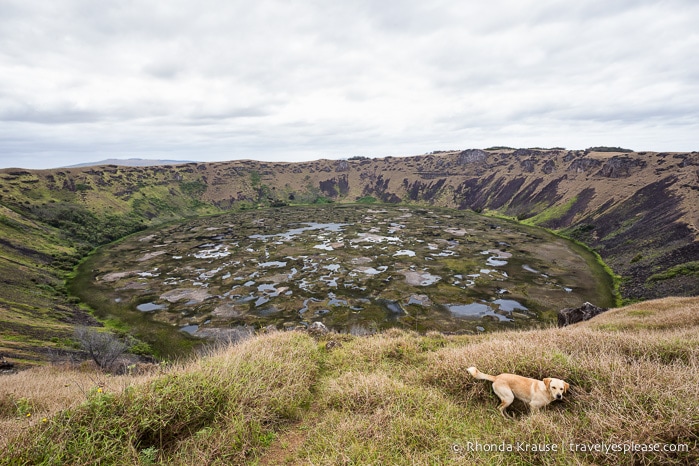
After 4 days in Easter Island, it was a nice change to visit somewhere that wasn’t all about moai carving. At Orongo, we got to learn about a whole different time period in the island’s history and experience aspects of another rare culture.
Tips for Visiting Orongo
- To enter Orongo, you will need to show your Rapa Nui National Park pass. The staff will stamp it with the date because you can only visit this site once.
- You now must be accompanied by a registered guide to visit Orongo and other national park sites on the island. You can hire a private guide or book a group tour. A list of local guides and their contact information can be found here.
- Orongo is open from 9:00 am- 5:30 pm (according to the Google listing). I have not been able to confirm these hours.
- Public toilets are available. At the time of our visit the fee was $1 US.
- We recommend parking down at the Rano Kau lookout point and doing the short hike along the crater’s edge to Orongo. It’s an easy walk through the grass and only takes about 15 minutes.
Information was updated in February 2025, but can change without notice. Please confirm directly with the venue.
Accommodations in Easter Island
For your convenience, here is a list of hotels in Easter Island. Please consider booking your Easter Island accommodations through the included link. It costs nothing extra and helps support this website. Thank you!
